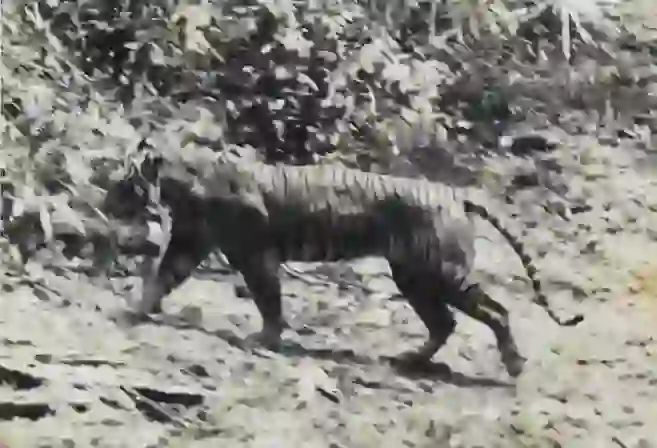
Javan Tiger
Javan Tiger
Javan Tiger
The island of Java, Indonesia. This island was once home to a beautiful tiger called the Javan tiger. They were small and characterized by their dark orange fur, but sadly, they are no longer with us. Let's explore the little-known ecology of the Javan tiger and the reasons behind their extinction.
Javan Tiger Basic Infomation

| Property | Value |
|---|---|
| Scientific Name | Panthera tigris sondaica |
| Taxonomic Status | SUBSPECIES |
| Rank | SPECIES |
| Vernacular Names | Javan Tiger |
| Kingdom | Animalia |
| Phylum | Chordata |
| Class | Mammalia |
| Order | Carnivora |
| Family | Felidae |
| Genus | Panthera |
| Habitats | Java, Indonesia (before extinction) |
| Descriptions | The Javan tiger was a subspecies of tiger that once lived on the Indonesian island of Java, and went extinct in the mid-20th century. It was a smaller tiger, characterized by its dark orange fur and numerous, narrow stripes. |
| Conservation Status | EXTINCT |

Size
They were one of the smaller tiger subspecies, measuring about 7 to 8.2 feet (2.1 to 2.5 meters) in length (including tail), with males weighing around 220 to 310 pounds (100 to 140 kilograms) and females weighing 165 to 243 pounds (75 to 115 kilograms).

Lifespan
While there are no accurate records, their lifespan in the wild is estimated to have been around 10 to 15 years, similar to other tiger subspecies.

Distribution
They were found only on the island of Java, Indonesia. They adapted to various environments on Java, including tropical rainforests and mountainous areas.
Javan Tiger Q&A

What kind of tiger was the Javan tiger?
The Javan tiger was the second smallest tiger subspecies after the Bali tiger.
They were characterized by their dark orange fur and numerous, narrow stripes. They also had shorter and sparser manes compared to other tigers. They lived in the forests and mountainous areas of Java, preying on deer and wild boar. They were primarily nocturnal and are thought to have been mostly solitary. The Javan tiger is believed to have gone extinct in the 1970s.

What did Javan tigers eat?
Javan tigers were carnivores, primarily preying on deer, wild boar, monkeys, and birds. They were skilled hunters, stalking their prey and then pouncing on it in a sudden burst of speed.
They used their sharp teeth and claws to kill their prey. They were also known for their ability to climb trees, sometimes hiding their kills in the branches to prevent other predators from stealing them.

Why did they go extinct?
The extinction of the Javan tiger was mainly due to human activities.
・Habitat destruction: Starting in the 19th century, the human population on Java rapidly increased, leading to deforestation and agricultural development. As a result, the Javan tigers' habitat rapidly dwindled.
・Extermination as pests: Javan tigers were hunted and killed as pests because they preyed on livestock.
・Sport hunting: Many Javan tigers were killed for sport.
・Poaching: Their bones and fur were highly valued and widely traded, leading to rampant poaching.
These combined factors led to the presumed extinction of the Javan tiger in the 1970s. The last Javan tiger was reportedly sighted in 1979 on Mount Merbabu.

[Quiz!] What did the Javan tiger represent to the people of Java?
The Javan tiger was a creature of fear and reverence for the people of Java.
They feared the Javan tiger as the 'King of the Forest' and an 'incarnation of spirits.' The Javan tiger frequently appears in Javan folklore and legends. It is also said that they sought the power of the Javan tiger to ward off diseases and disasters.

[Quiz!] Are Javan tigers truly extinct?
The Javan tiger is believed to have gone extinct in the 1970s. However, there have been some unconfirmed reports of tiger sightings on Java since then.
Therefore, some people speculate that the Javan tiger may still be surviving somewhere. However, none of these sightings have been confirmed, and it remains a mystery whether Javan tigers truly still exist. Experts are surveying the few remaining forests on Java to explore the possibility of Javan tiger survival. However, so far, no traces of them have been found.

[Quiz!] Is it possible to resurrect the Javan tiger?
In recent years, research has progressed on using biotechnology to resurrect extinct animals.
The Javan tiger has been suggested as a potential candidate for such efforts. If it were possible to bring back the Javan tiger, it would be a significant step for biodiversity conservation. However, there are various challenges involved in resurrecting extinct animals, such as ethical concerns and the potential impact on the ecosystem. Therefore, careful discussion is needed. Also, to resurrect the Javan tiger, their habitat would need to be restored. Deforestation and agricultural development have progressed on Java, leaving insufficient forest area for Javan tigers to thrive. Therefore, large-scale afforestation and forest restoration efforts would be necessary for the revival of the Javan tiger.

Would you like to become a part of the 'Animalbook.jp'?
Turn your knowledge into Q&A and share it with the world. ※Publication will be activated after purchase. Let's share information together!
Javan Tiger Type of List

Causes of the Javan Tiger's Extinction
- Habitat destruction: Deforestation and conversion to agricultural land
- Extermination as pests: Attacks on livestock
- Sport hunting: Hunting for entertainment
- Poaching: Their bones and fur were highly valued in the illegal wildlife trade
Information
Congratulations! You are the first commenter!

Create Your Favorite List!
Javan Tiger
Save the animals you love! Build your own list to quickly revisit your favorites later.

Would you like to leave a comment?
※Please note: This is for the purchase of rights to post comments within the article.
Find Your Favorites!
Our shop offers a unique and attractive selection of goods themed around various animals.
Javan Tiger References
Javan Tiger Introduction of media used

Andries Hoogerwerf (29 August 1906 – 5 February 1977), Public domain, via Wikimedia Commons

Collectie Wereldmuseum (v/h Tropenmuseum), part of the National Museum of World Cultures, CC BY-SA 3.0, via Wikimedia Commons

Help Enrich Our Animalbook.jp with Your Media!
We are constantly looking to expand and enrich our Animalbook.jp with amazing photos and videos of animals. If you have any media that you'd like to share, please contribute and help us showcase the beauty and diversity of the animal kingdom. Your submissions will be credited and featured in our encyclopedia, reaching a wide audience of animal lovers.


















